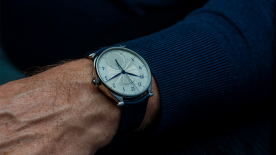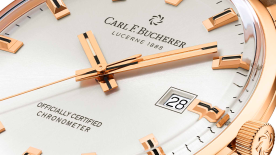Ever since clockmakers have been making watches, they have adorned, decorated and then animated them according to the fashions of the day and the tastes of their customers.
May 2007
P. Buser
Measuring time has been far from the only function of timekeepers. A watch was a sign of wealth, then ease, and only became popular after 1867 with the invention of the Roskopf watch.
The first Blois enamelled or richly engraved watches already depicted scenes with "scantily clad" figures which were, however, inspired by mythology and therefore not really regarded as saucy.
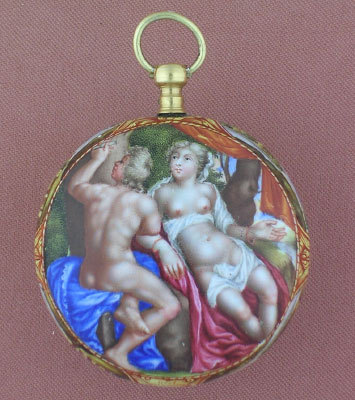 English watch signed "Cabrier London" with enamelled case signed "Huaut le Puisné fecit". (Coll. MHL) English watch signed "Cabrier London" with enamelled case signed "Huaut le Puisné fecit". (Coll. MHL) |
|
|
As already mentioned, the purely chronometric function of watches was swiftly enhanced with striking mechanisms and repeaters. Jaquemarts, small automata striking the hours which had already been seen in clocks on buildings, appeared on watch dials. These striking or musical mechanisms and the jaquemart automata were rapidly seized on by ingenious clockmakers to fulfil other functions.
The scenes are of course generally hidden on the back of the cuvette and are only revealed by the owner, often by a small opening mechanism dubbed, surely not by accident, "secret". On this magnificent timepiece from the MIH collection, we can see on the outside of the cuvette a scene picturing what appears to be a caring mother advising her young daughter (in fact Jupiter and Callisto) and inside the advice of her confessor.
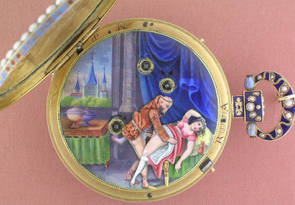 Pocket watch with enamel painting and musical automaton, circa 1820. (Coll. Musée International d'Horlogerie, La Chaux-de-Fonds) Pocket watch with enamel painting and musical automaton, circa 1820. (Coll. Musée International d'Horlogerie, La Chaux-de-Fonds) | 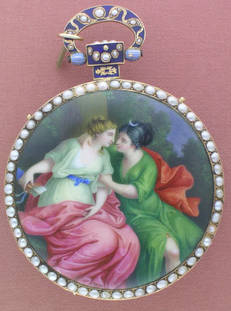 |
|
|
Different mechanical principles were employed to animate the scenes. The repeater mechanism was without doubt the most well-known means of animating a scene. Displayed here is a watch whose saucy scene is wholly independent of the timekeeping element. An entire plate is placed in front of the movement and is revealed and activated only when the cuvette is lifted. Closing it causes a rack to reload the mechanism ready for the next time it is opened.
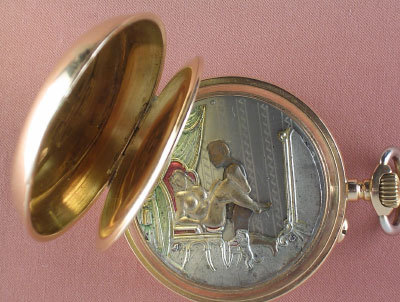 Pocket watch whose mechanism is reloaded by closing the cuvette. Late 19th century. (Private collection) Pocket watch whose mechanism is reloaded by closing the cuvette. Late 19th century. (Private collection) |
|
|
This inferior quality timepiece from the 19th century is simpler still. The automaton concealed by the back is animated manually by the crown which needs to be turned in the opposite direction of the winding function.
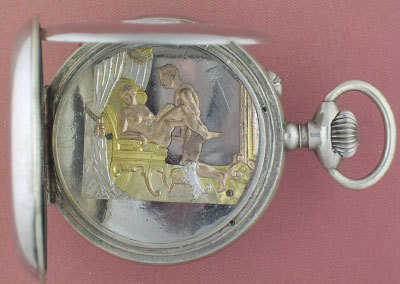 Pocket watch with manually activated automaton. Late 19th century. (MHL collection) Pocket watch with manually activated automaton. Late 19th century. (MHL collection) |
|
|
Note that the two watches displayed above have embossed metal automata, most probably made in the same workshop.
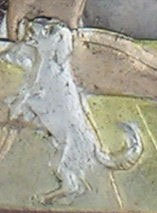 | 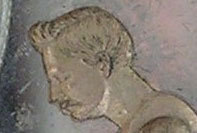 Pocket watch with manually activated automaton. Late 19th century. (MHL collection) Details. Pocket watch with manually activated automaton. Late 19th century. (MHL collection) Details.
(Any resemblance to famous animated cartoon characters is purely unintentional) |
|
|
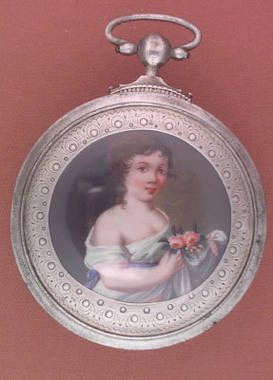 Pocket watch with enamel painting. The "scabrous" section is hidden by a bezel opening with a secret push piece. (MHL collection) Pocket watch with enamel painting. The "scabrous" section is hidden by a bezel opening with a secret push piece. (MHL collection) |  MHL collection (detail) MHL collection (detail) |
|
|
The themes in the scenes vary but certain subjects recur. The monk (missionary?) or other member of the clergy (see timepiece illustrated on page 1), the soldier (hussar?), the politician (Hours of Love, Volume 2, by Roland Carrera): a watch with an enamel painted scene entitled "Napoléon et Mlle Georges", surprised together while he was undoubtedly preparing an attack…), the scientist or the lovers of physics.
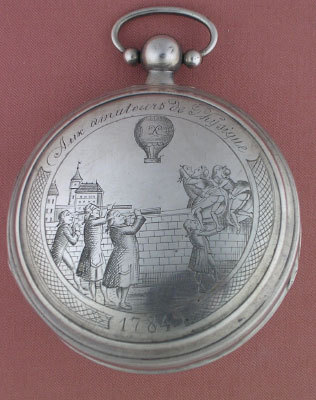 Silver pocket watch from 1784. (Coll. Deutsches Uhrenmuseum, Furtwangen) Silver pocket watch from 1784. (Coll. Deutsches Uhrenmuseum, Furtwangen) |
|
|
Voyeurs, at times involuntary yet highly attentive, are not forgotten and often occupy the background of the scene.
 | 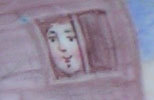 Louis XV style gilded pocket watch with two enamel painted scenes. (MHL collection) Louis XV style gilded pocket watch with two enamel painted scenes. (MHL collection) |
|
|
Needless to say, the quality of the enamel paintings and of the automata vary according to the object's value.
 Snuffbox cover with musical automata and enamel painting of exceptional quality. (Coll. Swiss National Museum, Seewen Snuffbox cover with musical automata and enamel painting of exceptional quality. (Coll. Swiss National Museum, Seewen |  Detail of a watch with superb painting on enamel signed Robert, Brandt et Cie. (Coll. Musée International d'Horlogerie, La Chaux-de-Fonds) Detail of a watch with superb painting on enamel signed Robert, Brandt et Cie. (Coll. Musée International d'Horlogerie, La Chaux-de-Fonds) | 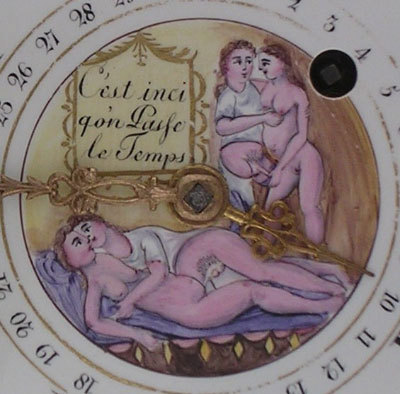 Pocket watch with painted enamel dial of average quality. (Coll. Deutsches Uhrenmuseum, Furtwangen) Pocket watch with painted enamel dial of average quality. (Coll. Deutsches Uhrenmuseum, Furtwangen) |
|
|
With the advent of photography and then cinema, painted scenes and saucy automata faded into oblivion. Some early-20th century watches do exist with mini-photographs of more or less crude scenes reproduced by a photographic process. They are generally of very poor quality. It was not until the 1970s that this genre would make a discreet return to manufacturers' catalogues. Nowadays, saucy watches once again occupy a niche, even at the very top end of the market.
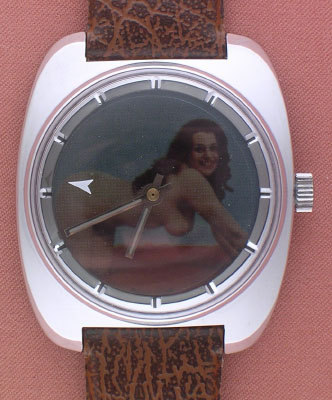 Mechanical bracelet watch whose saucy scene appears and disappears in response to the rotation of the polarised disc-seconds hand. (Coll. Beyer Museum, Zurich) Mechanical bracelet watch whose saucy scene appears and disappears in response to the rotation of the polarised disc-seconds hand. (Coll. Beyer Museum, Zurich) |
|
|
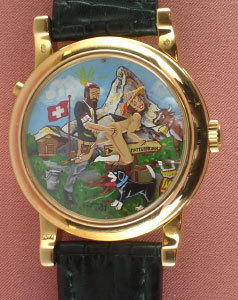 | 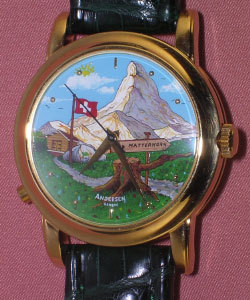 | | Gold dual face bracelet watch. Svend Andersen, Geneva. |
|
|
 Swatch "Pin-up" bracelet watch. (Private collection) Swatch "Pin-up" bracelet watch. (Private collection) |
|
|
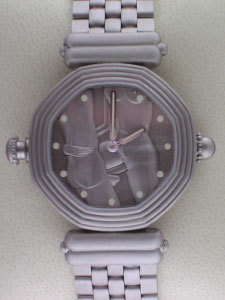 Minute repeater with automaton. Grey gold. Gérald Genta, Geneva. Minute repeater with automaton. Grey gold. Gérald Genta, Geneva. |
|
|
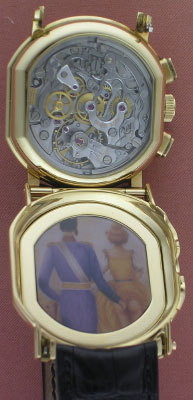 "Basculante" (pivot) strap watch in gold with chronograph and saucy scene. Daniel Roth, Geneva. "Basculante" (pivot) strap watch in gold with chronograph and saucy scene. Daniel Roth, Geneva. |
|
|
First erotic pendulum clock
Unlike watches with their hidden sauciness, antique pendulum clocks did not embrace this theme.
In his workshop at Auvernier (NE) in 1999, Thierry Amstutz created the first erotic pendulum clock called "libertine".
This clockmaker, technician and demonstrator of Jaquet-Droz automata at the Neuchâtel Museum of Art and History, a specialist restorer and maker of pendulum clocks, produced a silent timepiece in the style of Louis XIII with a double escapement, showing two people carved in limewood in the missionary position.
They are in perpetual motion, coiled up inside their white pearly hiding-place which opens up like a casket.
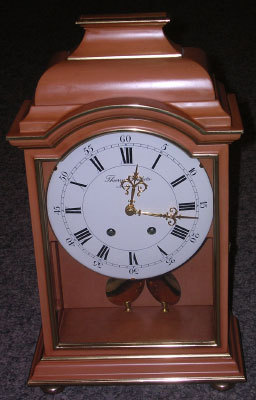 "Au Carillon d'Or", Pendulum Clock Workshop, Thierry Amstutz and Sons, Auvernier. "Au Carillon d'Or", Pendulum Clock Workshop, Thierry Amstutz and Sons, Auvernier. |
|
|
Antique saucy watches have been around for a long time. Some can still be found in museum and private collections. A number of them have however been sacrificed on the altar of morality.
In France, for example, their manufacture was outlawed and any items found were seized. As they were a source of amusement in turn to police officers or judges, it was decided to destroy them on the spot and return the precious metal to the owner.
The Genevan actor Michel Simon was a major collector of saucy timepieces, but his collection was broken up on his death and has unfortunately not been recovered, especially since no catalogue was ever produced.
In Neuchâtel, a number of pieces were made to the great displeasure of the Clergy, who reported them to the Governor in 1816.
“Very humble request to his Excellency the Governor from the Company of Pastors, 17 December 1816.” “Referred for examination and prompt appraisal by Messrs de Pierre, Mayor of Neuchâtel, and de Sandoz Rollin, Councillors of State, 24 December 1816.”
“Dear Governor, The undersigned Dean is charged by the Company of Pastors of this State to place before your Excellency an extract from a letter sent to him by Mr Duby, Pastor and Professor of Theology at Geneva, dated 25 November last, and seemingly from a committee of the Venerable Consistory of Geneva of which he is a member. Here is the verbatim transcript of the letter from Mr Duby, which appears to us to demand the full solicitude of your Excellency”.
“Obscene jewellery has long been manufactured in your Canton and in ours. These consist of paintings and mechanisms depicting lascivious scenes, placed in cachets, snuffboxes or watch cases. Our Consistory has only recently discovered or become aware of this. It has appointed a committee of which Mr Vaucher and I are members in order to look into the matter and see what can be done. We summoned the leading traders in clocks and jewellery.
It did not take long for us to impress on them how much such a business would damage Switzerland's reputation abroad, how morally corrupting it is as young people and even children see such works and there are women who work on them. They seemed ashamed of themselves and were all willing to abandon such trade, but we realised that to secure their commitment to no longer sell such items, we needed to be able to reply to them that the same commitment would be undertaken in your country. They will willingly renounce this wretched trade, but they fear that their refusal to continue it might cause them to lose out on commission. Could one not attempt to make a similar request of your clock sellers of Le Locle and La Chaux-de-Fonds? Could one not expect of them the same arrangements as ours out of principle and patriotism? Could Pastor Jaquemot and his colleague in Le Locle, if there is one, not inspire such a noble resolution in them? Will not your Clergy for the sake of its dignity take this to heart and unite with our Company to defend public morality, the honour of Switzerland and in particular of the two Protestant Cantons which have newly been joined with it? Please let me know as soon as you can what you think, what you hope, what you will do so that we do not allow our hearts to grow cold over this and that our two Cantons may promptly settle their Holy Alliance on this matter”.
“By forwarding the above letter to the Pastors of Le Locle and La Chaux-de-Fonds to call on their vigilance in an affair of such a serious nature, the Company did not feel it should dispense with submitting it to Your Excellency in the firm belief that you will find in your wisdom and your piety no less than in the authority placed in you the means of establishing the facts and, if necessary, of repressing such subversive assaults against decency that are likely to sully the reputation of honesty which has hitherto honoured this country abroad”.
“Please accept, Mr Governor, this token of my high consideration and my deep respect”.BerthoudPastor at Neuchâtel and Dean of the Clergy. This petition certainly made little change in reality but it seems that the manufacture of "lewd" watches was prohibited. In 1817, a "case" was investigated at La Chaux-de-Fonds. It involved a certain Samuel Dubois.
Justice is therefore served by introducing these timepieces of our horological past and future on this site, constructed by a certain Samuel Dubo
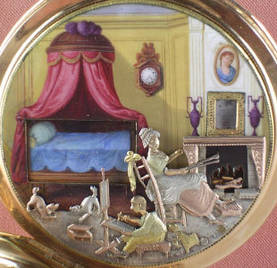 | 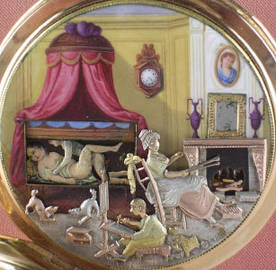 | | Magnificent pocket watch with music and hidden saucy automata. (Private collection) |
|
|
Photographs displayed: Giorgio Savini, Le Locle
Media kit photographs : Pierre Buser
 English watch signed "Cabrier London" with enamelled case signed "Huaut le Puisné fecit". (Coll. MHL)
English watch signed "Cabrier London" with enamelled case signed "Huaut le Puisné fecit". (Coll. MHL) Pocket watch with enamel painting and musical automaton, circa 1820. (Coll. Musée International d'Horlogerie, La Chaux-de-Fonds)
Pocket watch with enamel painting and musical automaton, circa 1820. (Coll. Musée International d'Horlogerie, La Chaux-de-Fonds)
 Pocket watch whose mechanism is reloaded by closing the cuvette. Late 19th century. (Private collection)
Pocket watch whose mechanism is reloaded by closing the cuvette. Late 19th century. (Private collection) Pocket watch with manually activated automaton. Late 19th century. (MHL collection)
Pocket watch with manually activated automaton. Late 19th century. (MHL collection)
 Pocket watch with manually activated automaton. Late 19th century. (MHL collection) Details.
Pocket watch with manually activated automaton. Late 19th century. (MHL collection) Details. Pocket watch with enamel painting. The "scabrous" section is hidden by a bezel opening with a secret push piece. (MHL collection)
Pocket watch with enamel painting. The "scabrous" section is hidden by a bezel opening with a secret push piece. (MHL collection) MHL collection (detail)
MHL collection (detail) Silver pocket watch from 1784. (Coll. Deutsches Uhrenmuseum, Furtwangen)
Silver pocket watch from 1784. (Coll. Deutsches Uhrenmuseum, Furtwangen)
 Louis XV style gilded pocket watch with two enamel painted scenes. (MHL collection)
Louis XV style gilded pocket watch with two enamel painted scenes. (MHL collection) Snuffbox cover with musical automata and enamel painting of exceptional quality. (Coll. Swiss National Museum, Seewen
Snuffbox cover with musical automata and enamel painting of exceptional quality. (Coll. Swiss National Museum, Seewen Detail of a watch with superb painting on enamel signed Robert, Brandt et Cie. (Coll. Musée International d'Horlogerie, La Chaux-de-Fonds)
Detail of a watch with superb painting on enamel signed Robert, Brandt et Cie. (Coll. Musée International d'Horlogerie, La Chaux-de-Fonds) Pocket watch with painted enamel dial of average quality. (Coll. Deutsches Uhrenmuseum, Furtwangen)
Pocket watch with painted enamel dial of average quality. (Coll. Deutsches Uhrenmuseum, Furtwangen) Mechanical bracelet watch whose saucy scene appears and disappears in response to the rotation of the polarised disc-seconds hand. (Coll. Beyer Museum, Zurich)
Mechanical bracelet watch whose saucy scene appears and disappears in response to the rotation of the polarised disc-seconds hand. (Coll. Beyer Museum, Zurich)

 Swatch "Pin-up" bracelet watch. (Private collection)
Swatch "Pin-up" bracelet watch. (Private collection) Minute repeater with automaton. Grey gold. Gérald Genta, Geneva.
Minute repeater with automaton. Grey gold. Gérald Genta, Geneva. "Basculante" (pivot) strap watch in gold with chronograph and saucy scene. Daniel Roth, Geneva.
"Basculante" (pivot) strap watch in gold with chronograph and saucy scene. Daniel Roth, Geneva. "Au Carillon d'Or", Pendulum Clock Workshop, Thierry Amstutz and Sons, Auvernier.
"Au Carillon d'Or", Pendulum Clock Workshop, Thierry Amstutz and Sons, Auvernier.


